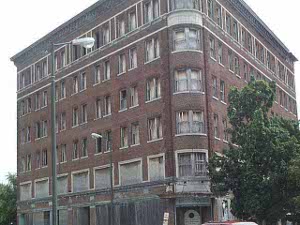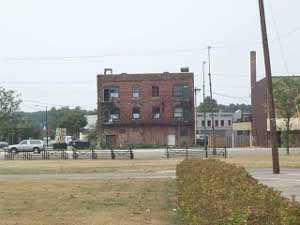 All boarded up
relatives lived for a time around 1900, so we came to spend a few days searching for marriage licenses and to continue our family history explorations.
All boarded up
relatives lived for a time around 1900, so we came to spend a few days searching for marriage licenses and to continue our family history explorations.
At the beginning of the time when electronics hobbies included building your own stereo and computer components, Heathkit was king. Benton Harbor, Michigan, was the company headquarters. It is also the city where several of Elsa's  All boarded up
relatives lived for a time around 1900, so we came to spend a few days searching for marriage licenses and to continue our family history explorations.
All boarded up
relatives lived for a time around 1900, so we came to spend a few days searching for marriage licenses and to continue our family history explorations.
We arrived in Benton Harbor fresh from several weeks in the more pastoral settings of Iowa, Wisconsin and Illinois. To say Benton Harbor was a shock is an understatement.
When we drove in to find the Benton Harbor Public Library, we were aghast -- the city seemed like a huge slum. Buildings were decaying everywhere, many stores were empty. See enclosed photos. But we persevered, and found the Library staff quite nice, with a good collection of local history. We found the wedding notices and obituaries on the microfilm copies of the local paper, and located the graves of relatives in the cemeteries. We also looked through the collection of books of local history. After the usual books about early pioneers and biographies of nineteenth-century settlers, we came upon one book which raised our eyebrows.
It's written by Alex Kotlowitz, and the title is "The Other Side Of The River: A Story of Two Towns, a Death, and America's Dilemma." It's about the  Only poverty and crime here
twin cities of Benton Harbor and St. Joseph, Michigan, which sit side by side along the shores of Lake Michigan, separated by the St. Joseph River. These are small towns, each about 10,000 people, but St. Joseph is rich and 95 percent white, while Benton Harbor is poor and 92 percent black. This area has the dubious distinction of being ranked by Money magazine, in 1989, as the worst place in America to live.
Only poverty and crime here
twin cities of Benton Harbor and St. Joseph, Michigan, which sit side by side along the shores of Lake Michigan, separated by the St. Joseph River. These are small towns, each about 10,000 people, but St. Joseph is rich and 95 percent white, while Benton Harbor is poor and 92 percent black. This area has the dubious distinction of being ranked by Money magazine, in 1989, as the worst place in America to live.
We think we understand what's going on here: white flight. Just as we feel the U.S. must do something about its urban underclass and street gangs, so we feel the U.S. must do something about white flight. We've barely started the Kotlowitz book (it took us two days to find it --the general bookstores were out of stock but we located it among Bibles and inspirational texts at a small black Christian college) so we'll wait to comment on what the author tells us. But just the appearance of Benton Harbor tells us that America (and Americans) cannot just turn and walk away from problems. We cannot afford to create pockets of poverty by the simple expedient of having all those making a decent living move away. It is unconscionable.
 Civic sculpture in vacant lot
Civic sculpture in vacant lot
Our hotel is on the outskirts of Benton Harbor, along the freeway. But even from a distance we can see the effects of the depressed economy. The hotel has trouble keeping staff; so do the restaurants. Equipment breaks down. There's a shopping mall, but with more than the usual number of empty and boarded-up shops. Benton Harbor is the county seat, but the courthouse has moved to St. Joseph, and the genealogical records are seven miles further south, in a "nice" area of the county along the river. So even the government is fleeing from Benton Harbor.
The hotels were crowded because we came on the weekend that St. Joseph was having a festival. There was no festival across the river in Benton Harbor, though.
We tend to get a little superstitious and sometimes believe that our mental attitudes and psychological condition affect our fortune. So, in this forbidding place, we weren't too surprised to find the first relative without a tombstone. She was the second wife, and stepmother to three grown sons. She was buried next to the rest of the family, but was the only one without a marker. Too bad.